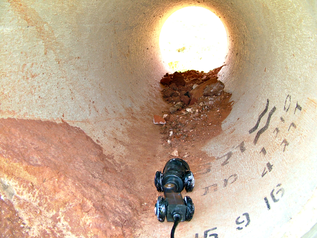Eye-Mole

Mini-robot Eye-Mole for tunnels.
Mini-robot explores city tunnels. He's small in size but with big ambitions on big opportunities, with panoramic video-imaging capabilities. Robot is a fully fledged surveillance with the ability to roll through mud, sand, snow, or even float under water if the need arises. At all this time the robot uses a pair of cameras to deliver its remote operator with a live video feed of the objects is spies on, in full stereoscopic 3D or uses twin cameras to take pictures that are offset at slightly different angles and perspectives (similar to techniques used in 3D cinema). Then, using a single point of reference on each, the photos are combined using computer software to triangulate a 3D-projection from a flat, two dimensional image. The robot can be controlled either by a human operator and a programmed autonomous mode, in which the takes snapshots of the images it sees. Users can opt from equipping the robot with all sort of cameras, including wide-angled and night vision camcorders, which add the built-in an acoustic microphone, that can detect the distant sounds, as well sensor as to the radioactivity, gas, humidity, fire, heat, smoke, biological material, explosives. The robot can move around at a top speed of 5-10 km/h (6 mph), and is virtually inaudible. The robot is particularly useful for detecting blockages in the tunnels to fit through a hole in a stone door at the end of a narrow tunnel, the obtained scan video representation of 3D in resolution HD. Ability to move through the tunnel to a distance of 1,500 meters, with passage rotates to 90 degrees. Ability to complete the robot is minimum size tunnel 12cm in diameter.

A 3D is a motion picture that enhances the illusion of depth perception. Derived from stereoscopic photography, a regular motion picture camera system is used to record the images as seen from two perspectives (or computer-generated imagery generates the two perspectives in post-production), and special projection hardware and/or eyewear are used to provide the illusion of depth when viewing the film.

The System-video combines image processor with a new high-sensitivity sensor. This sensor incorporates back-illuminated architecture which lowers noise levels by up to 60%, allowing to capture high quality videos in low light conditions such as capturing a well exposed subject against a dark, night-time background or a moving subject when shooting indoors.








